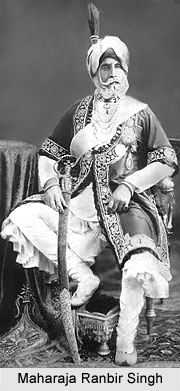 Ranbir Singh, popularly known as General Shriman Rajrajeshwar Maharajadhiraj Sri Sir Ranbir Singhji, Indar Mahindar Bahadur, Sipar-i-Sultanat, Mushir-i-Khas-i-Kaiser-i-Hind GCSI, CIE, Kaiser-i-Hind, was the head of the Jamwal Rajput clan and Maharaja of the princely state of Jammu and Kashmir from 1857- 1885. He was born in August 1830 and belonged to the Dogra Dynasty. During his reign, the trans-Himalayan regions of Gilgit, Hunza Nagar and Astore were conquered and included in the territory of Jammu and Kashmir. Ranbir Singh was a well known and reputed scholar of classical Persian and learned English, Sanskrit and Pashtu.
Ranbir Singh, popularly known as General Shriman Rajrajeshwar Maharajadhiraj Sri Sir Ranbir Singhji, Indar Mahindar Bahadur, Sipar-i-Sultanat, Mushir-i-Khas-i-Kaiser-i-Hind GCSI, CIE, Kaiser-i-Hind, was the head of the Jamwal Rajput clan and Maharaja of the princely state of Jammu and Kashmir from 1857- 1885. He was born in August 1830 and belonged to the Dogra Dynasty. During his reign, the trans-Himalayan regions of Gilgit, Hunza Nagar and Astore were conquered and included in the territory of Jammu and Kashmir. Ranbir Singh was a well known and reputed scholar of classical Persian and learned English, Sanskrit and Pashtu.
Rule of Ranbir Singh
General Shriman Rajrajeshwar Maharajadhiraj Sri Sir Ranbir Singhji, Indar Mahindar Bahadur, Sipar-i-Sultanat, Mushir-i-Khas-i-Kaiser-i-Hind GCSI, CIE, Kaiser-i-Hind ascended the throne of Jammu and Kashmir after the death of his father in the year 1857. Maharaja Ranbir Singh became very popular with his subjects as the territory made significant progress under his rule. He focused his attention in the restructuring and re-organisation of the state administration and 3 distinct departments were established that dealt with civil, revenue and military affairs. Moreover, regular Courts of Justice were established and uniform laws were framed to make justice system more effective and efficient. A new State Panel Code titled Shri Ranbir Dandh Bidhi was also issued. The people could seek remedy at the public Darbars of the Maharaja as well.
Ranbir Singh also took various efforts to promote trade and industry; the means of transport and communication were developed and the system of taxation was refurbished. Several imports were abolished and tax on shawl manufacturers was reduced. Postal system was made more competent and Postal services between Muree and Srinagar was also introduced. Telegraph links were also set up between Jammu and Srinagar as well. He also renovated various old bridges and constructed new bridges as well over the Anantnag, Baramulla, Srinagar and Jhelum. Singh also initiated an effort to levy the land revenue at a fixed rate for the benefit of the farmers. Numerous hospitals and medical dispensaries were built and other schools and other educational institutes were also established.
Maharajadhiraj Sri Sir Ranbir Singh was most renowned for his patronage of learning and scholarship and earned the esteem of his subjects. He set up a department for the compilation and publication of significant works on the Hindu Law and Ritual in Sanskrit language; and for the translation of Persian and Sanskrit manuscripts into Hindi language as well. This compilation of Sanskrit manuscripts, now preserved in the Raghunath temple library, is amongst the most valuable works in the country. Trade and commerce between the British East India Company and Central Asia was carried on through the region of the state. Maharaja Ranbir Singh reduced transit duties in the year 1863. Later in 1870, a commercial treaty was concluded between the British Government and between that resulted in the obliteration of all the duties. It was done in return for a analogous concession by the Indian Government on trade and commerce between the Jammu and Kashmir and British India. In the year 1877, the British administration reached an agreement with Maharaja Ranbir Singh for setting up a Political Agency at Gilgit. Although it was withdrawn due to critical circumstances in 1881, but 8 years later it was re-established.
During the end of the reign of General Shriman Rajrajeshwar Maharajadhiraj Sri Sir Ranbir Singhji, Indar Mahindar Bahadur, Sipar-i-Sultanat, Mushir-i-Khas-i-Kaiser-i-Hind GCSI, CIE, Kaiser-i-Hind, the region of Kashmir was severely affected by the negative effects of the great famine of 1877- 1879. Moreover, trade and commerce also suffered to a great extent. In order to prevent the destructive effects of famines in future, Ranbir Singh initiated the construction of a cart road from Srinagar to Rawalpindi. The land revenue assessment was revised as well.
Personal Life of Ranbir Singh
Maharajadhiraj Sri Sir Ranbir Singh was married for 5 times and had 6 children, including 2 daughters and four sons, namely Mian Lakshman Singh, Hari Singh, General Raja Sir Amar Singh, KCSI, Kaiser-i-Hind, General Raja Sir Ram Singh, KCB, Kaiser-i-Hind and Maharaja Pratap Singh, who succeeded Ranbir Singh as the Maharaja of Jammu and Kashmir in the year 1885.
Ranbir Singh died on 12th September, 1885 and was succeeded by Pratap Singh who was his eldest son.



















